Popplet is used in classrooms across a range of subjects, and while our visual thinking app quickly comes to mind in the English and creative arts classrooms, we are also seeing Popplet used in the STEM subjects of science, technology and math.
Let’s look at some of the ways that Popplet is used to enhance science subjects at all grade levels — from elementary to university. It won’t be long before we are sure we see Popplet is used from the classroom all the way through to the laboratory!
Popplet As a Skills Base in the Science Classroom
Science teaches a particular skill set around how to conduct enquiries and solve problems. The success of science education often depends on how well these skills are developed. We see Popplet being used by teachers to help students practice some of these skills, and we also see students choosing to organize their science studies using Popplet.
Popplet helps students organize their science studies:
- As a note-taking app that can help collate new ideas and organize concepts into categories
- To help the left and right brain work in unison by combining rational notes with creative mind mapping
- To set homework assignments and self-study plans
- To map out experiments and record findings
- To undertake subject revision.
Popplet’s ability to embed drawings, photographs, videos and texts in the one canvas provides students with an exciting, participatory method to plan and carry out tasks. Mind mapping is of great use in the science classroom to help clarify how particular concepts and ideas link together.
Teachers are using Popplet in the science classroom to set homework assignments. Ms Schewczyk uses Popplet for science homework projects, requiring students to collate their notes on Newton’s laws of motion in Popplets after every class. The homework goal is for students to show how they have understood new terms and formulas, and how they have sourced example images and videos. Students are assessed on how clearly their mind map shows what they are learning, and even includes a mark for when students share the Popplet with Ms Schewczyk as a collaborator for assessment.
With Popplet, projects are mapped, experiments are planned, team roles assigned, and information shared. Results and comments can be recorded in real time amongst teams. … and study conclusions can even be presented! Dr Carol Webb even encourages her Masters of Science students to use Popplet to help them “make nicer diagrams in dissertations”.
Popplet helps independent learners to take study notes and revise subjects. Ideas can be linked during class time and visual reminders of important information created. Being able to organize thoughts and review scientific subjects visually often adds much needed fuel to weary neurons as the end of a new science subject nears at exam times!
Using Popplet for science revision is central to how student Adam Wright looks back at his science studies in Organic Chemistry:
1. Geography
At Herschel Grammar, science students started using their new class iPads with Popplet in the Geography class to map natural hazards:
Our new iPads are starting to be used in some lessons this week – mind mapping natural hazards in Geography with @poppletny
— Herschel Grammar (@HerschelGrammar) September 8, 2014
The Geography Department of Tampines Secondary School uses Popplet extensively in their class, for example, when studying the role of transport:
2. Physics
Shropshire UK teacher Stuart Kettle has been turning an often complex science subject like physics into a compelling, engaging and approachable area of study by creating visually attractive and highly informative diagrams.
Stuart prepares revision Popplets for each area of study in his Physics classes, such as this look at “The Advantages and Disadvantages of Radiation”:
3. Chemistry
The more theoretical elements of chemistry can be one of the most challenging areas of science for students to grasp — and for chemistry teachers to teach!
This elegantly presented popplet shows how foundation subject matter like chemical bonding can illuminate this beautiful, but often elusively confusing area of science.
All the main ideas here have been symmetrically laid out and linked, combining a range of source materials including some fantastic diagrams and quick-study videos embedded on the page.
4. Environmental science
It is exciting to see the next generation of students having to address our impacts on the environment as a standard part of the science curriculum. With climate change and a growing population, how we live in harmony with the natural world around us will become a question we must answer in our daily lives.
So it is wonderful to see third graders starting to grapple with environmental science issues of global importance. EPiC Elementary uses a project-based learning approach to encourage our next generation of environmental leaders to understand and manage our cities and environmental resources:
Using @poppletny to study cause/effect & answer the Q, “How can man made disasters effect ecosystems?” #lpsepic pic.twitter.com/1Ch7P56dlG
— EPiC 3rd Grade (@EPiC3rdGrade) November 20, 2014
5. Engineering
Year 10 students at Eastern High DT are using Popplet to think about current challenges in using resources and materials for construction. Collaboration — the essential aid to scientific progress — has never been easier. Here, Popplet helps discussion around the composite materials needed to construct the buildings of the future:
Y10 engineering making #popplet rich pictures on composite materials. More engaging than mind maps #digitallearning. pic.twitter.com/z2ToNhkzZ1
— Eastern High DT (@EasternHighDT) September 30, 2014
Whatever area of science education you are involved in and at whatever level, Popplet has something to offer. Using Popplet in Science education can quite literally fire the imagination of students, exciting them about subjects that used to be considered some of the most dense, boring and difficult to grasp amongst the curriculum.
Share your science Popplets with our community on Twitter and on our Facebook page. Interested in seeing how other teachers are using Popplet in the science classroom? Have a quick scan through our public popplets and you will regularly come across examples of how teachers and students are pushing the limits of scientific enquiry with Popplet at their side.
But for now, let’s leave the last word to student Nitaa:
Finally sci popplet finished
— Nitaa (@fadedxrainbowx) July 22, 2014

